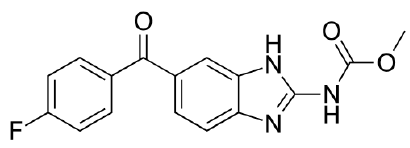Moorland grouse - Flubendazole use for parasitic worm control: preliminary environmental assessment
A report assessing the potential impact on the wider environment of the use of flubendazole in medicated grit.
2. Information on the substance
In the compilation of this report the open literature was searched for published papers relating to flubendazole’s properties, use, ecotoxicity and presence in the environment. The authors also made contact with researchers working in the area of grouse moor best practices and relevant regulators in relation to authorised uses of products containing flubendazole and any relevant grey literature.
2.1 Intended uses
Flubendazole is one of a family of benzimidazoles used as anthelmintics (treatment of intestinal parasitic worms in livestock and humans). In the UK it is authorised for use in pigs and poultry as a feed or drinking water additive. Although use quantities are not available, the VMD Product Information Database lists eight products that are currently authorised for use in the UK (five for use in pigs, six in chickens and four in geese, partridge, pheasants or turkeys)[2]. Although authorised for use in humans in Europe, it is not listed on the British National Formulary and does not seem to be prescribed or available in over the counter products (NHS Scotland, personal communication).
Medicated grit is available by veterinary prescription only and as flubendazole is not licensed for use in grouse in the UK, prescribing products containing it is achieved through application of the cascade mechanism. Based on low exposure to the environment in its various uses, no higher tier prospective assessment for the environment was carried out as part of the authorisation process (VMD, personal communication). For its use in grouse treatments, flubendazole is the active ingredient in Flubenvet, present at 5% w/w, incorporated into a stearate coating onto grit (for other livestock incorporation into feed is recommended). Dose quantities vary but are around 1kg of the product in 1 tonne of grit (equating to approx. 50g flubendazole per tonne).
2.2 Substance Identification
Flubendazole (CAS 31430-15-6; IUPAC name methyl N-[6-(4-fluorobenzoyl)-1H-benzimidazol-2-yl]carbamate; figure 1) is a substituted benzimidazole anthelmintic that works by binding to β-tubulin and inhibiting microtubule formation in the intestinal cells, inducing decreased glucose uptake and starving of the parasites (Martin 1997). Wagil et al (2015) state that microtubules serve a variety of important functions in animal, plant, fungi and some bacterial cells so evaluating these anthelmintics for potential effects in aquatic flora and fauna is relevant.

2.3 Physico-chemical properties
Flubendazole has low water solubility (<10 mg/l, likely <0.05mg/l based on analogue data), an appreciable octanol-water partition coefficient (log Kow 2.91) and is ionisable with pKa values of 3.6 and 9.6; at environmentally relevant pHs the substance will almost entirely exist in its neutral form (Wagil et al 2015 and references therein).
2.4 Fate and Behaviour
In soil, the substance is rather immobile with a high measured water-organic carbon partition coefficient (log Koc >3.94 L/kg & 4.00 L/kg (Bundschuh et al 2016)). Half-lives in water and sediment (at 20 deg C) are given as 60 and 542 days respectively (Bundschuh et al 2016). Degradation studies in manure and manured soils also indicate it is relatively persistent in the terrestrial environment (DT50 174 days in clay soils after standard manure application; Kreuzig et al 2007). The substance’s lack of primary degradation is likely a result of its poor bioavailability. There is conflicting evidence as to the substance’s photodegradation, but this removal mechanism will be less relevant in top soils and for adsorbed substances. The substance’s log Kow indicates it is unlikely to bioaccumulate.
Contact
Email: john.gray@gov.scot
There is a problem
Thanks for your feedback